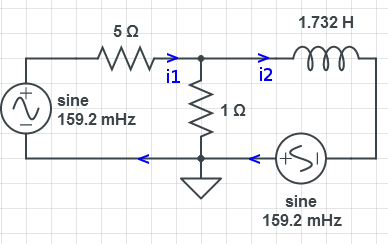Circuit Theory/Example70
The series components can be lumped together .. which simplifies the circuit a bit.
Node Analysis
Mesh Analysis
Solving
Which is the same as the voltage through the 1 ohm resistor.
Thevenin voltage
Make ground the negative side of , then:
Solving
Norton Current
-
short out the load
-
split into two circuits so can use superposition
-
half the circuit is shorted out by shorting the voltage sources
Thevenin/Norton Impedance
short voltage sources, open current sources, remove load and find impedance where the load was attached
check
yes! they match
Evaluate Thevenin Equivalent Circuit
Going to find current through the resistor and compare with mesh current
yes! they match
Find Load value for maximum power transfer
Find average power transfer with Load that maximizes
Simulation
The circuit was simulated. A way was found to enter equations into the voltage supply parameters which improves accuracy:
-
type sqrt(3) instead of a numeric approximation
-
added pi/2 to convert from cos to sin sources
To compare with the results above, need to translate the current and voltage through the resistor into the time domain.
Period
Period looks right about 6 seconds ... should be:
Current
Current through 1 ohm resistor, once moved into the time domain (from the above numbers) is:
From the mesh analysis, the current's through both sources were computed:
The magnitudes are accurate, they are almost π out of phase which is can be seen on the simulation.
Voltage
The voltage is the same as the current through a 1 ohm resistor:
The voltage of the first (left) source is:
The magnitudes match. The voltage through the source peaks before the current because the first source sees the inductor.
The voltage through the resistor should peak about 171 - 45 = 126° before the source ... which it appears to do.











